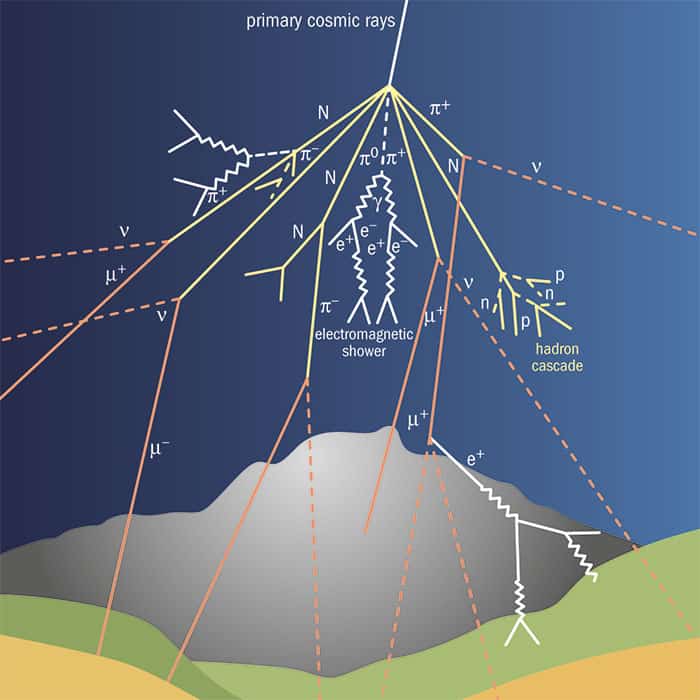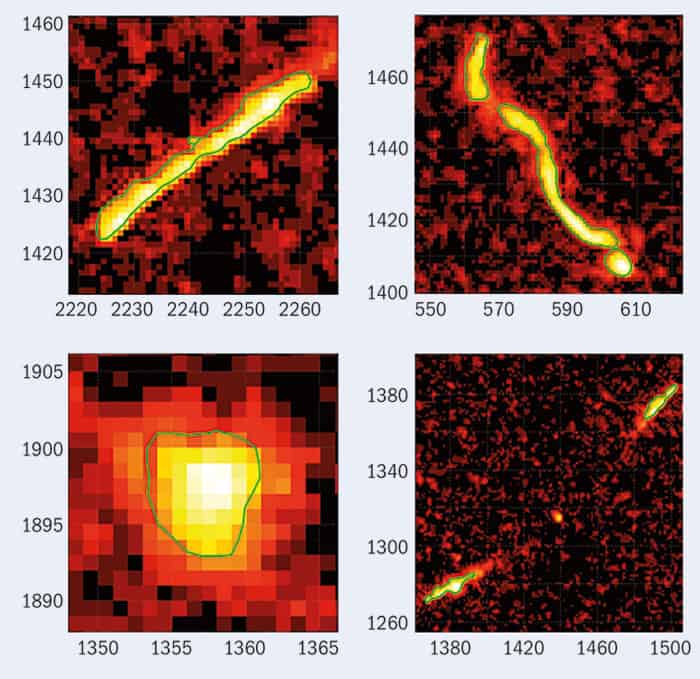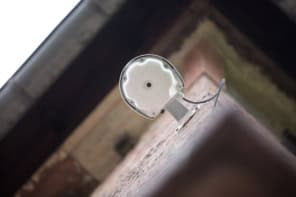New apps allow smartphone users to join the hunt for ultrahigh-energy cosmic rays. Edwin Cartlidge asks whether networks of these miniature particle detectors might outperform huge multi-million-dollar observatories

Harnessing the technology, and curiosity, of the public in the pursuit of scientific discovery is nothing new. For at least 15 years, Internet-connected computers have been exploited collectively to number-crunch data generated by everything from the hunt for extraterrestrial radio signals to experiments on how proteins fold. While there are still no signs of alien intelligence, this distributed approach to problem-solving has produced results – such as the discovery of dozens of new quasars by the Einstein@Home project. To date, however, such “citizen science” initiatives have processed data collected by professional scientists. Two new projects, based at the University of Wisconsin–Madison and the University of California, instead rely on observations carried out by members of the public, via a gadget that has become a fundamental part of many people’s day-to-day existence: the smartphone.
As their names suggest, both apps – the Distributed Electronic Cosmic-ray Observatory (DECO) and Cosmic Rays Found in Smartphones (CRAYFIS) – transform smartphones into miniature cosmic-ray detectors. They use the CMOS chips inside phones’ onboard cameras to detect the secondary particles produced when cosmic rays – energetic, charged subatomic particles arriving from beyond the solar system – collide with air molecules in the Earth’s atmosphere (figure 1 below).

All you need to get started is to download the app from the Internet (see links at the end of this article), plug your phone in and then place it face-up on an opaque surface. With the camera obscured in this way, the CMOS pixels are more or less shielded from visible photons but remain exposed to particles from cosmic-ray showers, such as higher-energy photons and muons, which can pass through walls, tables and plastic phone cases to generate a measurable voltage when they ionize atoms of silicon. The resulting pattern of bright pixels is stored within the phone as a stream of data, which is then uploaded to a central server to be analysed whenever a wireless Internet connection becomes available (figure 2 below).
The two apps, which were in the final stages of beta development as Physics World went to press, will be used as educational tools, providing both school students and members of the public with a hands-on, readily available means for exploring aspects of astrophysics, particle physics and nuclear physics. But it is hoped that they could also be used to carry out original research.
According to CRAYFIS developer Daniel Whiteson of the University of California, Irvine, the near ubiquity of smartphones makes them ideal instruments to try and intercept the particle showers produced by the very highest-energy cosmic rays – the origins of which still remain a mystery to physicists.

He points out that existing cosmic-ray observatories occupy thousands of square kilometres of land and cost tens of millions of dollars to build, whereas a smartphone-based detector network would require no physical space and its costs would be limited to the computing equipment needed to collect and process data. “There are something like two billion smartphones out there,” he says. “It is a valuable infrastructure that we need to take advantage of.”
Pocket detectors
This is not the first time that mobile phones have been used as radiation detectors. For several years, apps have allowed smartphone users to detect radon leaks at home or to record cosmic-ray doses onboard aircraft, for example. A year ago, physicists at the Idaho National Laboratory in the US said that they had developed a new algorithm that allows CMOS cameras to be used as detectors of ionizing gamma rays and which, among other things, could be used to carry out initial measurements of fallout in the event of a nuclear meltdown. Astronomers, meanwhile, have known for many years about the tracks left by cosmic rays in the images they take with CCD cameras, which they usually regard as background radiation that needs removing.
The latest work inverts that logic, based as it is on algorithms that search for signals of cosmic rays against a background of ambient radioactive decays, thermal fluctuations and electronic noise. Conventional cosmic-ray observatories use numerous particle detectors that are fixed in space and spread sparsely over large areas of the Earth’s surface in order to maximize the chances of intercepting the particle showers from the most scientifically interesting rays – those that strike the atmosphere with at least 1019 eV. Scientists have still to identify an astrophysical process with enough power to generate such ultrahigh-energy cosmic rays, and have not yet observed enough of the rays to pinpoint their origin in the sky, given that only about one of them arrives over any given square kilometre of land every century. Detecting them in sufficient quantities would require a far larger facility than the biggest that exists today – the 3000 km2, $53m Pierre Auger Observatory in Argentina. (See “100 years of cosmic rays” by Alan Watson, August 2012 pp35–40.)
The appeal of turning instead to mobile phones is that, in principle at least, bagging more rare events is simply a question of getting more people to download the app. The idea of using the “mini particle detector in your pocket” as Whiteson puts it, came to Whiteson and his particle-physicist colleague Michael Mulhearn of the University of California, Davis over beers one evening in late 2013 while they were working on the Large Hadron Collider (LHC) at CERN in Geneva. Their work on the ATLAS and CMS detectors meant they had experience of the CMOS technology used in smartphones, but at the same time they had become frustrated with working inside large collaborations. “We asked ourselves how we could do something interesting on a smaller scale,” says Whiteson, “and as we were chatting and playing with our phones it occurred to us that the phones themselves could provide the answer.”

The pair then set about calculating how many smartphones would be needed to do real scientific research, given the limited size and efficiency of phones’ CMOS sensors. As they explain in a paper published on the arXiv preprint server (arXiv:1410.2895), they worked out that to be confident of intercepting almost every shower produced by cosmic rays with an energy of at least 1020 eV, some 1000 activated phones would be needed in each square kilometre of coverage – the idea being that at least five phones should register a hit within five seconds of one another in order to distinguish signals from (uncorrelated) noise. The researchers also calculated how big an area they would need to cover in order to match Pierre Auger’s “exposure” – the product of its observing area, field of view and duration of data taking – and the answer they came up with was 825 km2. They therefore concluded that the total number of phones needed would be around 825,000.
The magic million
As Whiteson admits, that is a lot of phones. Nevertheless, he is confident of meeting the target. He and his colleagues were due to release the CRAYFIS app at the end of 2014, having held it back while upgrading their servers to handle the large number of expected users. Within several weeks of publicizing the project in mid-October, they had signed up some 50,000 people to help test the beta version of the app, and were planning for “one big PR push” before 2015. They were also designing a number of ways to maximize interest, such as getting users involved in data analysis and adding the names of particularly productive individuals to future scientific papers. “I think we can reach the one million mark,” he says.
Alan Watson of the University of Leeds, one of three physicists to propose the Pierre Auger Observatory in the early 1990s, praises the two apps as “really imaginative” and notes that their developers have the advantage of not having to “deal with the farmers.” Instead, as he puts it, “you will have one million landlords who are taking part voluntarily.” However, Watson questions just how well a smartphone-based network will be able to perform. In particular, he takes issue with the assumption by Whiteson and colleagues that smartphone cameras will have an 80° field of view, estimating the real figure to be closer to 45°. He also points out that using muons to measure cosmic rays’ energy, as Whiteson’s group is planning to do, relies on uncertain model-based values of muon production rates.
Pierre Auger spokesperson Karl-Heinz Kampert of the University of Wuppertal in Germany has a more fundamental objection. He argues that individual smartphones have such a low probability of detecting particles from a cosmic-ray shower that any hits they do register are likely to be drowned out by background noise. In addition, he thinks it is unlikely that the number density of phones will ever get high enough to meet the five-phone triggering criterion. Kampert also believes the California researchers have overestimated the energy and angular resolution possible with a smartphone network.
Doubts about just how much research these apps will be able to carry out are shared as well by DECO creator Justin Vandenbroucke of the University of Wisconsin–Madison. As Vandenbroucke points out, not even the iconic distributed-computing project set up to search for signs of alien intelligence, SETI@home, has managed to attract as many participants as a smartphone-based cosmic-ray observatory would need (it currently has around 120,000 active users). He adds that interpreting the results obtained by smartphones will be complicated by the fact that a portion of a cosmic-ray shower is absorbed as it passes through the walls of buildings and that this absorption varies from user to user. Rather than using DECO to calculate cosmic rays’ energy and direction, his group is instead concentrating on the more basic identification of particle events recorded by phones – muons for example, tending to leave straight tracks within CMOS images. “We have the philosophy that if we can do extensive air-shower cosmic-ray physics that is great but if not there is still a lot we can do in education and outreach.”
DECO is publicly available and has so far been downloaded several thousand times, according to Vandenbroucke. There are a number of minor technical issues that still need ironing out, he says, such as the fact that the shutter-effect sound cannot currently be switched off on certain smartphone models – which can prove quite irritating when images are captured once every second or so, as they are with DECO. Vandenbroucke and his colleagues are also working on a user-friendly interface to allow participants to analyse their own data, and are working with teachers to integrate the technology into school curricula. In addition, he says, they plan to collaborate with the CRAYFIS team. “These apps make the science more accessible,” he adds. “People are used to reading about the LHC but here they can use the exact same detector principles on a much smaller scale using their own devices.”
Whiteson too believes the smartphone detectors could prove a valuable asset in school classrooms. But he is adamant that their use need not be limited to education. “We might get only 100,000 users and do no science, but we could get 50 million and if we did we would have 50 times the observational power of the world’s biggest telescope,” he says. “We might also see things we hadn’t anticipated. When you build something new you often get unexpected results.”
- You can download the CRAYFIS and DECO apps by visiting crayfis.ps.uci.edu/join.php and wipac.wisc.edu/deco.



